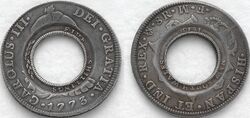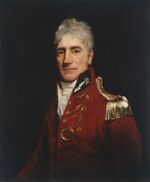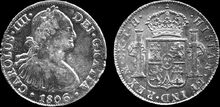- This article is about the coins produced in 1813. For coins of the same denomination listed in Unusual World Coins, see New South Wales 5 shilling coin (medallic)
| 5 shillings | |
|---|---|

| |
| A holey dollar stamped over a 1778 coin | |
| General information | |
| Country | |
| Value |
5 shillings = ¼ pound |
| Years |
1813 (countermarked over dated coins) |
| Measurements and composition | |
| Mass |
20.981 g |
| Diameter |
39 mm |
| Composition |
silver |
| Appearance | |
| Shape |
round with hole |
| Host coin |
|
| Obverse |
Value |
| Reverse |
State title, year |
| v · d · e | |
The 5 shilling coin, often referred to as the holey dollar, is a countermarked coin produced by New South Wales in 1813 and circulated from 1814 to 1829. Holes were punched in the centers of 8 real coins (often referred to as "dollars") from Bolivia, Mexico, Peru, and Spain, hence the term "holey dollar".
History[]

Lachlan Macquarie
When New South Wales was established in 1788, problems soon arose concerning the lack of coinage. Early on, foreign coins, including those from Britain, India, the Netherlands, and Portugal, were commonly circulated in the colony. However, many of these coins left the area as people traded with visiting merchants.
To overcome the shortage of specie, Governor Lachlan Macquarie (1762–1824) began to use 10,000 pounds worth of imported Spanish dollars sent by the British government to produce coins for the colony. Such coins were brought over by the HMS Samarang from Madras (now Chennai), via the East India Company, on November 26, 1812. Macquarie enlisted convicted forger William Henshall (1770–?) to cut the centers out of the coins and counter stamp them. The resulting coins were stamped with a value of 5 shillings, while the central plugs (often referred to as a dump) were used for producing 15 pence coins. Of the 40,000 imported Spanish coins, 39,910 holey dollars were made. These converted coins were put into circulation in 1814.
The government of New South Wales began to recall the holey dollars and dumps in 1822 and replace them with coins of the British pound sterling. By the time the holey dollar was demonetized in 1829, most of the 40,000 coins in circulation had been exchanged for legal tender or melted down for silver. Numismatic experts estimate that only 350 holey dollars remain, and as a result, such coins are considered extremely rare and often bring high prices at auctions. A holey dollar produced from a Peruvian 8 real coin of Lima was sold at an auction in Melbourne, Australia, on March 6, 2013, for approximately US$508,000, the highest amount ever paid for such a coin.
The Perth Mint of Australia issued a 1 dollar coin in 2013 commemorating the 200th anniversary of the holey dollar, using the obverse design of the original 1813 coin. It was accompanied by a commemorative 25 cent coin for the dump.
Description[]

An 1806 8 real coin of Mexico
The holey dollar is composed of silver (normally of .903 fineness), weighs approximately 20.981 grams, and measures roughly 38 to 39 millimeters in diameter. In the center is a hole measuring approximately 19 millimeters. The value "FIVE SHILLINGS" is stamped around the hole on the obverse, while the title "NEW SOUTH WALES" and the date are inscribed in a similar location on the reverse. Spanish 8 real coins from Bolivia, Mexico, Peru, and Spain dated between 1757 and 1810 were used as hosts for holey dollars, and thus, 5 shilling coins of New South Wales bear the designs and legends used on such coins. Most examples were struck over coins bearing portraits of Kings Charles III (1716–1788) and IV (1748–1819) and Ferdinand VII (1784–1833) on the obverse and the coat of arms of Spain on the reverse, excluding one coin produced using a 1757 Mexican 8 real coin of Ferdinand VI (1713–1759), which displays an image of two crowned globes between the Pillars of Hercules instead of a portrait of the reigning monarch.
| Host 8 real coins | ||
| Location minted | Mint | Years |
| Bolivia | Potosí (PTS) | 1773–1808 |
| Mexico | Mexico City (Mo) | 1757, 1772–1810 |
| Peru | Lima (IJ) | 1772–1810 |
| Spain | Madrid (M) and Seville (C) | 1788–1808 |
References[]
Holey dollar on the English Wikipedia
- Numismatic Guaranty Corporation website
- Numista – 5 Shillings - George III "Holey Dollar"
- Yahoo! News – Rare Australian Coin Fetches Record Sale Price
| Coins of Australian states and territories | |
|---|---|
| Cocos (Keeling) | Official tokens: 5¢ • 10¢ • 25¢ • 50¢ • 1 R • 2 R • 5 R • 10 R • 25 R 1977 coins: 5¢ • 10¢ • 25¢ • 50¢ • 1 R • 2 R • 5 R • 10 R • 25 R • 150 R 2003-2004 coins: 5¢ • 10¢ • 20¢ • 50¢ • $1 • $2 • $5 • $100 |
| New South Wales | 15 p • 5/- • 5/- (medallic) |
| Southern Australia | Adelaide: £1 • £5 |
| Victoria | Hodgkin, Taylor, & Tyndall: ¼ oz • ½ oz • 1 oz • 2 oz • 4 oz • 4 p Taylor: 6 p • 1/- Taylor & Wiener: 1/- Unknown: ½ p |
